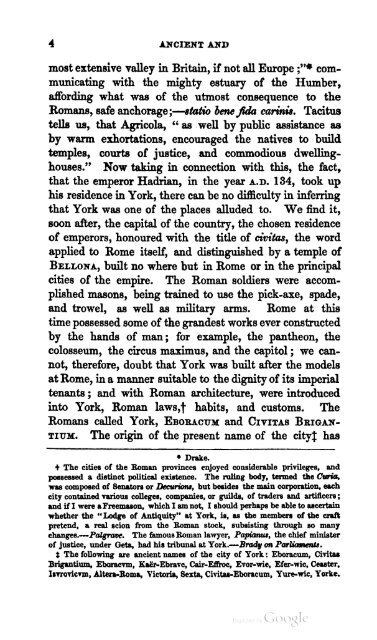Ancient_and_modern_York_a_guide
You also want an ePaper? Increase the reach of your titles
YUMPU automatically turns print PDFs into web optimized ePapers that Google loves.
4 ANCIENT AND<br />
most extensive valley in Britain, if not all Europe ;"* com<br />
municating with the mighty estuary of the Humber,<br />
affording what was of the utmost consequence to the<br />
Romans, safe anchorage ;—statio bene Jida carinis. Tacitus<br />
tells us, that Agricola, " as well by public assistance as<br />
by warm exhortations, encouraged the natives to build<br />
temples, courts of justice, <strong>and</strong> commodious dwellinghouses."<br />
Now taking in connection with this, the fact,<br />
that the emperor Hadrian, in the year a.d. 134, took up<br />
his residence in <strong>York</strong>, there can be no difficulty in inferring<br />
that <strong>York</strong> was one of the places alluded to. We find it,<br />
soon after, the capital of the country, the chosen residence<br />
of emperors, honoured with the title of civitas, the word<br />
applied to Rome itself, <strong>and</strong> distinguished by a temple of<br />
Beexona, built no where but in Rome or in the principal<br />
cities of the empire. The Roman soldiers were accom<br />
plished masons, being trained to use the pick-axe, spade,<br />
<strong>and</strong> trowel, as well as military arms. Rome at this<br />
time possessed some of the gr<strong>and</strong>est works ever constructed<br />
by the h<strong>and</strong>s of man; for example, the pantheon, the<br />
Colosseum, the circus maximus, <strong>and</strong> the capitol ; we can<br />
not, therefore, doubt that <strong>York</strong> was built after the models<br />
at Rome, in a maimer suitable to the dignity of its imperial<br />
tenants ; <strong>and</strong> with Roman architecture, were introduced<br />
into <strong>York</strong>, Roman laws,f habits, <strong>and</strong> customs. The<br />
Romans called <strong>York</strong>, Ebobactjm <strong>and</strong> Civitas Bbigantiitm.<br />
The origin of the present name of the cityj has<br />
• Drake.<br />
+ The cities of the Roman provinces enjoyed considerable privileges, <strong>and</strong><br />
possessed a distinct political existence. The ruling body, termed the Curia,<br />
was composed of Senators or Decurians, but besides the main corporation, each<br />
city contained various colleges, companies, or guilds, of traders <strong>and</strong> artificers ;<br />
<strong>and</strong> if I were a Freemason, which I am not, I should perhaps be able to ascertain<br />
whether the "Lodge of Antiquity" at <strong>York</strong>, is, as the members of the craft<br />
pretend, a real scion from the Roman stock, subsisting through so many<br />
changes.—Palgrave. The famous Eoman lawyer, Papianus, the chief minister<br />
of justice, under Geta, had his tribunal at <strong>York</strong>.—Brady on Parliaments.<br />
t The following are ancient names of the city of <strong>York</strong> : Eboracum, Civitas<br />
Brigantium, Eboracvm, Kacr-Ebravc, Cair-Effroc, Evor-wic, Efer-wic, Ceastcr,<br />
IsTrovicvm, Altera-Eoma, Victoria, Seita, Civitas-Eboracum, Yure-wic, <strong>York</strong>e.















